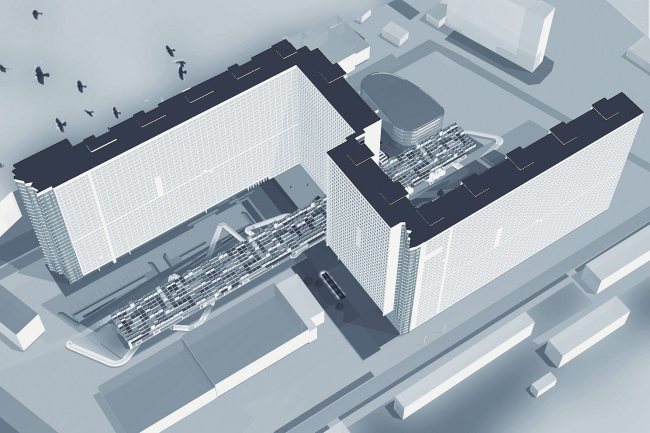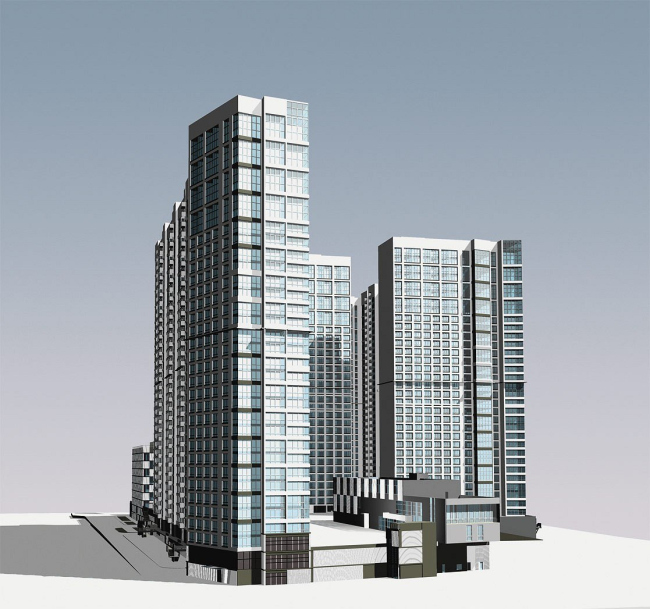|
Published on Archi.ru (https://archi.ru) |
|
| 05.06.2006 | |
|
Cell of a megacity |
|
|
Julia Tarabarina |
|
| Architect: | |
| Vladimir Plotkin | |
| Studio: | |
| Creative Union ‘Reserve’ | |
|
The complex "Air bus" is a rare example of the elite house for Moscow, not using habitual in this genre the form of a tower. Its architecture directly and fairly, not hiding behind a decor, beats a theme of a huge residential building - a component of a megacity, that, however, does not exclude also art subtleties.
Two huge 35-storeyed Ã-shaped plates form a huge zigzag, from height of the bird's flight reminding two hands linked by tips of fingers. In a place of "coupling" where approach, but do not adjoin corners of two cases, transitions - the arch leading from the northern court yard in to the southern and the closed transition between houses are arranged. Here passes a longitudinal axis of quarter along which in one line uninhabited constructions of a complex - three-storied fitness-center and six-storied office building are placed. The architecture of a complex amazes with the open honesty of the forms. Houses do not hide the cellular nature of well organized ant hill inherent in any multiflat complex, on the contrary, this feature is underlined and even is hypertrophied. The houses are very big and very checkered. Facades are lined by an equal grid which in the first variant was even more homogeneous, than now (later developers have asked to increase proportions of the cells belonging to penthouses). In a combination to the fine module of identical "windows" the scale of a complex is represented huger, than it is in deed, it shows the basic feature – it is precisely structured, supplied all necessary and density populated "city" inside very big megacity, a component clearly expressing an essence of whole. According to Vladimir Plotkin, « … if we have a ten-million city it somehow should be expressed in architecture ». It is simple to notice, that Plotkin’s complex goes counter with the developed for the last decade tradition of the elite construction in Moscow, preferring towers, which become a symbol of housing well-being. The tower can be one, or a few, but nevertheless, in opinion of a modern muscovite the expensive house should be a tower, and the house-plate inevitably casts memories of typical panel construction. This conjuncture which has spontaneously developed on a wave of counteraction to the Soviet past, - the architect simply does not notice it. The remote similarity to plates of the panel houses, emerging in consciousness of any Moscow inhabitant, as though does not exist for Plotkin, and we examine his houses more detailed, we understand, that in this case - indeed, the similarity is only external. First of all, in Plotkin’s house the cells of a facade though correspond in general to the structure of internal premises, but do not depend on them completely because the external figure belongs to the "screen" of a ventilated facade. White lines lining it - thin, bigger than the glass, and each "large" cell is inside divided twice, all big facades are lined by two crossed thick lines, and proportions are approached to a gold section. Rigidity of a geometrical grid is broken by "casual" impregnations - the white spots hiding blocks of communications. All together creates the ambiguous, multilevel rhythm which is starting with a simple action and from time to time "playing" in infringements of own rules. However strict geometrical rationalism is inherent in this ensemble only in large planes. Small elements of a complex with a success resist the hole organization of big one: face facades are divided up by the planes broken under a corner and it seems , that plates of houses are broken from something greater by a supernatural hand, and thus with fragmentary edges, thrust into the ground. Along the longitudinal axis of a site, nestling on the ground, the motley buildings of the fitness-center framed by winding angular paths last. So, strictly structured house-quarter appears to be not alien to the "ornaments", understood not banal, in the form of volutes, but on scale, according to scope of an architectural and building plan. NoneNoneNoneNone None |
|



